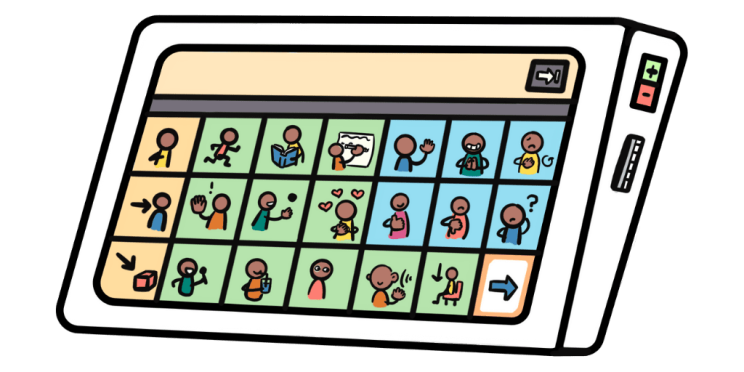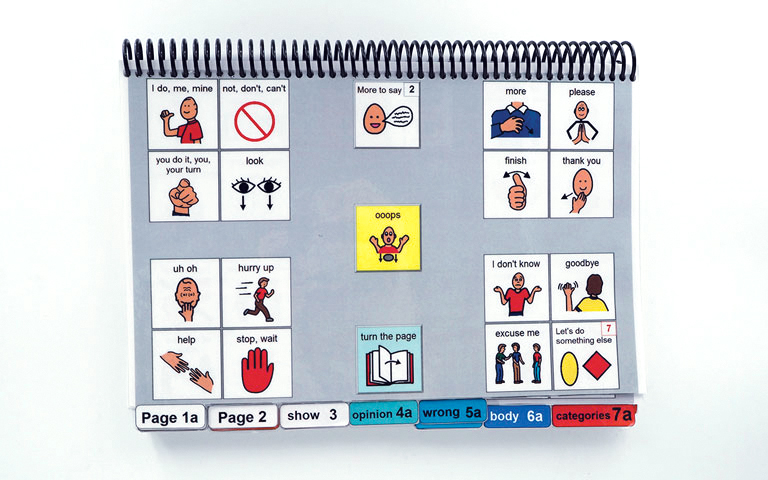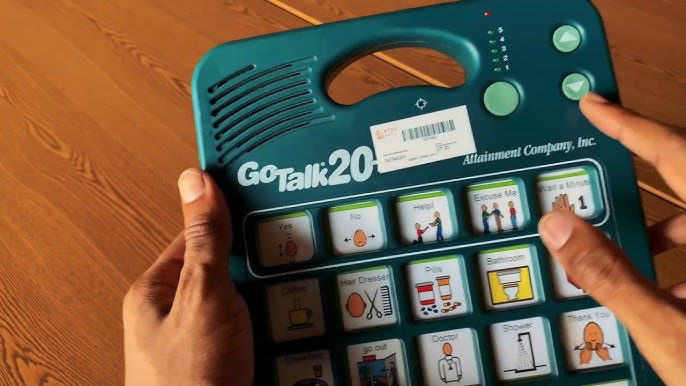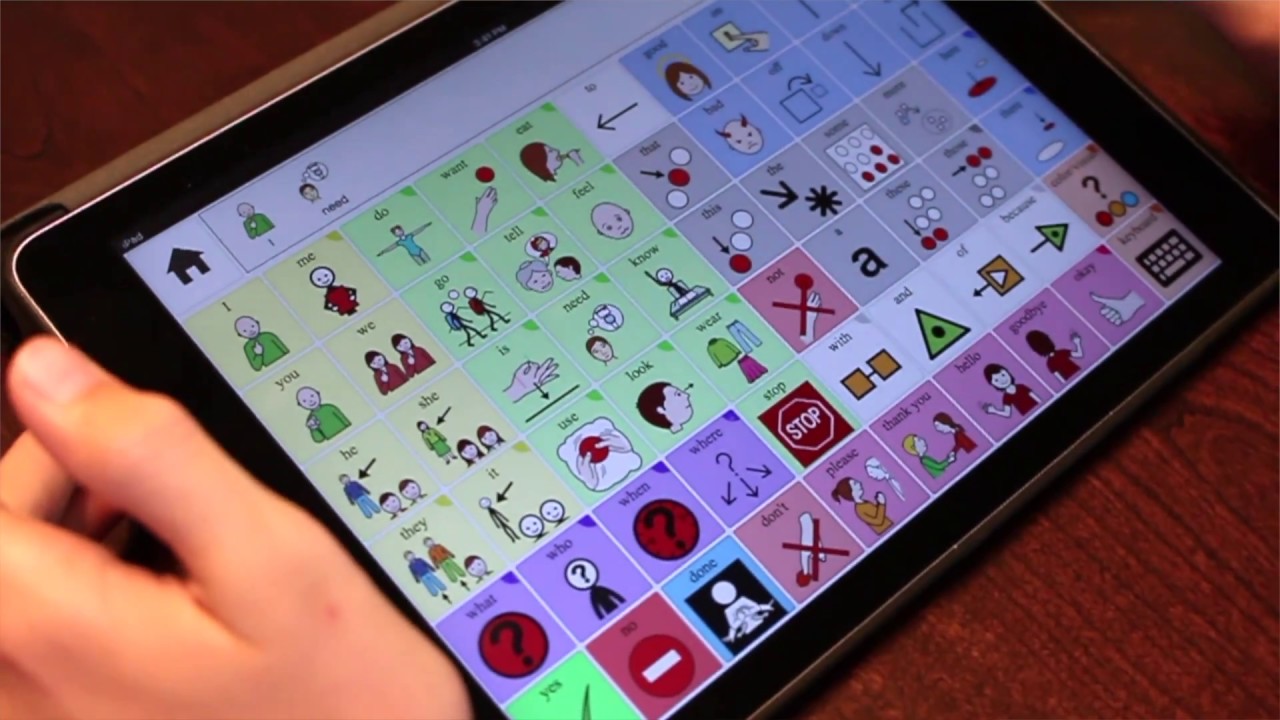Starting With AAC
Welcome! Now is a great time to get started!
Welcome to the world of AAC! Below are some materials that can help you get started on your AAC journey. We want everyone to feel comfortable learning about AAC in the way that works best for them, so feel free to use these materials any way you’d like.
Topics
What is AAC?
 Augmentative and Alternative Communication (AAC) is actually
a whole category of different kinds of tools and strategies.
The main purpose of AAC is to help people express themselves
when they may not always be able or comfortable using their natural voice. AAC can also help people develop a deeper
understanding of language, and make it easier for them
to express themselves. AAC is often printed on paper,
activated by buttons that speak, or organized on a tablet or
phone for more advanced speech output.
Augmentative and Alternative Communication (AAC) is actually
a whole category of different kinds of tools and strategies.
The main purpose of AAC is to help people express themselves
when they may not always be able or comfortable using their natural voice. AAC can also help people develop a deeper
understanding of language, and make it easier for them
to express themselves. AAC is often printed on paper,
activated by buttons that speak, or organized on a tablet or
phone for more advanced speech output.
AAC empowers individuals to convey their thoughts, needs, and emotions, which can lead to improved language development. It can serve as a bridge to gradually transition from non-verbal or limited verbal communication to more robust language skills, promoting social interaction and emotional well-being. Overall, AAC is a valuable resource that fosters language growth and enhances the quality of life for individuals with communication difficulties.
With the aid of AAC, many individuals enjoy full and productive lives, able to respond to questions and communicate independently throughout their days.
Here’s a list of some AAC options across different categories:
High Tech AAC
- Tablet-Based AAC Systems: Specialized software running on tablets that can be customized for individual needs.
- Communication Apps: Apps installed on tablets or smartphones with text-to-speech functionality, such as Proloquo2Go or TouchChat.
- Eye-Tracking AAC Systems: Devices that track eye movement to select symbols or words on a screen.
- Alternative Access Apps: For those physically unable to use the touchscreen, SGDs offer flexible access options including: Eye-gaze Head tracking Joystick and alternative mouse control Single and multiple switch control Thus, even children with severe physical disabilities can operate a life-changing AAC device.
Pros:
|
Cons:
|
It's important to remember that the choice of AAC system depends on an individual, everyone has different needs, preferences and abilities. Professional consultants like speech-language pathologists can provide an assessment, which will help in selecting the most appropriate AAC solution for each person. Additionally, the field of AAC continues to evolve with advancements in technology, so new solutions may become available over time.
Getting Started with AAC
Getting Help - AAC Evaluations
 Anyone is welcome to start using AAC tools and strategies on
their own, but it may be useful consult with a professional.
Assistive Technology evaluations are available to people of all ages throughout the state of Utah. Parents can at any time submit a request for their child’s school team to complete an AAC evaluation. It is recommended that this request be in formal or in writing for your records. The Utah Assistive Technology Teams complete AAC evaluations for school aged children throughout the state. More information can be found on their website: Utah Assistive Technology Teams.
Anyone is welcome to start using AAC tools and strategies on
their own, but it may be useful consult with a professional.
Assistive Technology evaluations are available to people of all ages throughout the state of Utah. Parents can at any time submit a request for their child’s school team to complete an AAC evaluation. It is recommended that this request be in formal or in writing for your records. The Utah Assistive Technology Teams complete AAC evaluations for school aged children throughout the state. More information can be found on their website: Utah Assistive Technology Teams.
The Utah Center for Assistive Technology (UCAT) is a statewide resource offering information and technical services to help people with disabilities acquire and use assistive technology devices. UCAT offers free evaluations to anyone within the state of Utah.
If you are seeking a free consultation with UCAT, please fill out a referral form and email it to ucat@utah.gov.
AAC Takes Time - Try to be Patient and Consistent
 Some people take to AAC very quickly, and some can take
months or even years to develop comfort and proficiency. It can
be discouraging for AAC users and those around them if progress happens more slowly than expected. One of the best indicators for whether AAC is eventually proven useful for an individual is
how supportive and engaged their support team is around them, so
if you are helping an AAC user it is important to be patient
and not to abandon support strategies too early or without consutling with the rest of the team.
Some people take to AAC very quickly, and some can take
months or even years to develop comfort and proficiency. It can
be discouraging for AAC users and those around them if progress happens more slowly than expected. One of the best indicators for whether AAC is eventually proven useful for an individual is
how supportive and engaged their support team is around them, so
if you are helping an AAC user it is important to be patient
and not to abandon support strategies too early or without consutling with the rest of the team.
Daily Activities and Routines
 Think about some routines or activities that happen
frequently. If it’s hard to remember to use AAC all the time,
it may be useful to try to make it part of a routine. Think
of what words or ideas could be useful and practice using them
or showing an AAC how they could use them if they wanted.
They don’t have to be specific to the situation, words like “more”, “make”, “go” and “done” can be used in many
different activities and can be great starter words.
Think about some routines or activities that happen
frequently. If it’s hard to remember to use AAC all the time,
it may be useful to try to make it part of a routine. Think
of what words or ideas could be useful and practice using them
or showing an AAC how they could use them if they wanted.
They don’t have to be specific to the situation, words like “more”, “make”, “go” and “done” can be used in many
different activities and can be great starter words.
Remember that there is a difference between using AAC to make someone hit a button, and using AAC as a tool for communication. If you find yourself directing an AAC user by telling them what they should say, think instead of open-ended opportunities for communication where you may show them some possible things they could say, but leaving the choice of what or whether to say anything up to them.
AAC Basic Concepts
Common Concerns
 Will using AAC block progress with natural speech development?
Numerous studies have shown that AAC interventions can actually support and enhance natural speech development in individuals with communication disorders. AAC can serve as a bridge to improve communication skills and eventually reduce the need for AAC devices.
Will using AAC block progress with natural speech development?
Numerous studies have shown that AAC interventions can actually support and enhance natural speech development in individuals with communication disorders. AAC can serve as a bridge to improve communication skills and eventually reduce the need for AAC devices.
Is AAC a last resort? Early intervention with AAC has been shown to be effective in improving communication outcomes for individuals with communication difficulties. Waiting too long to implement AAC can hinder a person’s overall communication development.
Is AAC very expensive? While some high-tech AAC devices can be costly, there are low-cost and even free AAC options available, such as communication apps for tablets and smartphones. The cost should not be a barrier to access.
Is AAC only for children? AAC can be beneficial for individuals of all ages, including adults with acquired communication disorders, progressive conditions, or degenerative diseases.
Is it better to focus on regaining natural speech? For acquired conditions like ALS or head injuries, AAC can serve as a short- or long-term element of a person’s communication strategy. AAC can work in tandem with efforts to restore natural speech, or as a gradual replacement in degenerative situations.
Is there a minimum age to start using AAC? AAC can be started at any age, and has been used to support communicators younger than three years old.
More Available at Frequently Asked Questions
Language Development

Children move through several different stages as language develops beginning at the cooing stage, into words, two-three word sentences, etc. Children who need AAC to help them develop language begin in the same position as children who don’t use that type of strategy for support.
Understanding AAC and language development | A Language Development Lens for AAC
Core Words
 Core words are those words that make up the majority of the vocabulary used in day to day communication. They help people express their wants and needs. Core words are important because they help the AAC user express a wide variety of concepts with only a few words.
Using core words is a good place to start using an AAC. You can go as slow or as fast as you want adding in words as you feel work for the user.
Core words are those words that make up the majority of the vocabulary used in day to day communication. They help people express their wants and needs. Core words are important because they help the AAC user express a wide variety of concepts with only a few words.
Using core words is a good place to start using an AAC. You can go as slow or as fast as you want adding in words as you feel work for the user.
PrAActical AAC Year of Core Vocabulary Words | Core Word of the Week List
Modeling

All children learn best when language is being modeled in a variety of meaningful contexts. Children using AAC learn the same way, through modeling. When our children are babies, we talk to them a lot, modeling language continually throughout the day. When they begin talking we don’t stop modeling language, we keep modeling. The same is true for AAC users. They need modeling, a lot of modeling and then they need a variety of natural contexts to practice their AAC language. We need to remember, receptive language skills (modeling AAC language) develop before expressive language skills do (using their AAC device to communicate). Just as babies experiment with sounds and words, AAC users play around (explore and experiment) and push buttons on their device to get to know it before their language becomes meaningful. AAC users must be taught when to use their device and when to listen just as non AAC users do is specific situations as in a classroom setting. They should always have the device available to them. Taking away a device is like taping a child’s mouth shut.
Keys to Successful Modeling | Partner-Assistetd Communication Strategies
Communication Partners
 This is a term that is used to describe someone you are speaking
or interacting with. Literature and vidoes may talk about
the “AAC user” and the “communication partner” as the two
people in a one-on-one conversation. A communication partner
can be a peer, co-worker, therapist, family member, etc.
This is a term that is used to describe someone you are speaking
or interacting with. Literature and vidoes may talk about
the “AAC user” and the “communication partner” as the two
people in a one-on-one conversation. A communication partner
can be a peer, co-worker, therapist, family member, etc.
Additionally, communication partners may sometimes also aid the AAC user in getting their thoughts across. One strategy for this is called partner-assisted scanning. PrAACtical AAC Getting Started With Partner-Assisted Scanning. Some AAC users rely on communication partners to help get their thoughts across. This brief video provides ideas on how communication partners can use auditory or visual scanning techniques to increase the expressive language of AAC users
Communication Bill of Rights
In collaboration the practitioners and AAC users, the Communication Bill of Rights was created to assert and remind that everyone, no matter their perceived limitations, should be treated with respect and be allowed the freedom to drive their own existence and interact with others through communication.

Have Fun!
 It’s easy to think about AAC as a clinical, medical process. But
remember to have fun! AAC is communication, and if communication
is reduced to trying to get the right answer or if it’s always
about work, then it loses a huge part of its meaning. Open-ended
interactions are an integral part of any communication strategy,
and making things fun is a great way for everyone to be
surprised by what happens!
It’s easy to think about AAC as a clinical, medical process. But
remember to have fun! AAC is communication, and if communication
is reduced to trying to get the right answer or if it’s always
about work, then it loses a huge part of its meaning. Open-ended
interactions are an integral part of any communication strategy,
and making things fun is a great way for everyone to be
surprised by what happens!
 Utah Center for AAC Excellence
Utah Center for AAC Excellence

